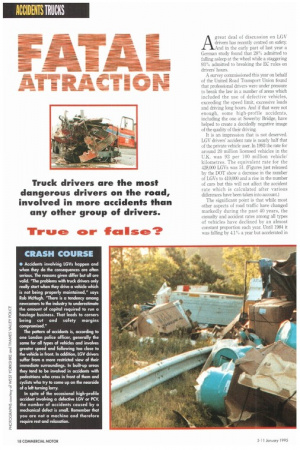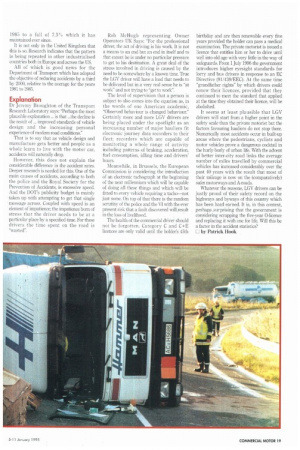FATAL
Page 20

Page 21

If you've noticed an error in this article please click here to report it so we can fix it.
ATTRACTION
Truck drivers are the most dangerous drivers on the road, involved in more accidents than any other group of drivers.
Truj r fcals4m1?
AAgreat deal of discussion on LGV drivers has recently centred on safety nd in the early part of last year a German study found that 28% admitted to falling asleep at the wheel while a staggering 93% admitted to breaking the EC rules on drivers' hours.
A survey commissioned this year on behalf of the United Road Transport Union found that professional drivers were under pressure to break the law in a number of areas which included the use of defective vehicles, exceeding the speed limit, excessive loads and driving long hours. And if that were not enough, some high-profile accidents, including the one at Sowerby Bridge, have helped to create a decidedly negative image of the quality of their driving It is an impression that is not deserved. LGV drivers' accident rate is nearly half that of the private vehicle user. In 1993 the rate for around 20 million licensed vehicles in the U.K. was 93 per 100 million vehicle/ kilometres. The equivalent rate for the 428,000 LGVs was 51. (Figures just released by the DOT show a decrease in the number of LGVs to 410,000 and a rise in the number of cars but this will not affect the accident rate which is calculated after various differences have been taken into account.) The significant point is that while most other aspects of road traffic have changed markedly during the past 40 years, the casualty and accident rates among all types of vehicles have declined by an almost constant proportion each year. Until 1984 it was falling by 4.1°0 a year but accelerated in 1985 to a fall of 7.5°c which it has maintained ever since.
It is not only in the United Kingdom that this is so. Research indicates that the pattern is being repeated in other industrialised countries both in Europe and across the US.
All of which is good news for the Department of Transport which has adopted the objective of reducing accidents by a third by 2000, relative to the average for the years 1981 to 1985.
Explanation
Dr Jeremy Broughton of the Transport Research Laboratory says: "Perhaps the most plausible explanation ... is that the decline is the result of ... improved standards of vehicle design and the increasing personal experience of modern road conditions."
That is to say that as vehicle design and manufacture gets better and people as a whole learn to live with the motor car, accidents will naturally drop.
However, this does not explain the considerable difference in the accident rates. Deeper research is needed for this. One of the main causes of accidents, according to both the police and the Royal Society for the Prevention of Accidents, is excessive speed. And the DOT's publicity budget is mainly :taken up with attempting to get that single :message across. Coupled with speed is an element of impatience; the impatience born of stress that the driver needs to be at a particular place by a specified time. For these drivers the time spent on the road is "wasted". Rob McHugh representing Owner Operators UK Says: "For the professional driver, the act of driving is his work. It is not a means to an end but an end in itself and to that extent he is under no particular pressure to get to his destination. A great deal of the stress involved in driving is caused by the need to be somewhere by a known time. True the LGV driver will have a load that needs to be delivered but in a very real sense he is "at work" and not trying to "get to work".
The level of supervision that a person is subject to also comes into the equation as, in the words of one American academic, "Observed behaviour is changed behaviour." Certainly more and more WV drivers are being placed under the spotlight as an increasing number of major hauliers fit electronic journey data recorders to their fleet; recorders which are capable of monitoring a whole range of activity including patterns of braking, acceleration, fuel consumption, idling time and drivers' hours.
Meanwhile, in Brussels, the European Commission is considering the introduction of an electronic tachograph at the beginning of the next millennium which will be capable of doing all these things and which will be fitted to every vehicle requiring a tacho—not just some. On top of that there is the random scrutiny of the police and the VI with the ever present risk that a fault discovered will,result in the loss of livelihood.
The health of the commercial driver should not be forgotten. Category C and C+E licences are only valid until the holder's 45th birthday and are then renewable every five years provided the holder can pass a medical examination. The private motorist is issued a licence that entitles him or her to drive until well into old age with very little in the way of safeguards. From 1 July 1996 the government introduces higher eyesight standards for lorry and bus drivers in response to an EC Directive (91/439/EEC). At the same time "grandfather rights" by which drivers could renew their licences, provided that they continued to meet the standard that applied at the time they obtained their licence, will be abolished.
It seems at least plausible that LGV drivers will start from a higher point in the safety scale than the private motorist but the factors favouring hauliers do not stop there. Numerically most accidents occur in built-up areas where the pedestrians, cyclists and motor vehicles prove a dangerous cocktail in the burly-burly of urban life. With the advent of better inter-city road links the average number of miles travelled by commercial vehicles has increased considerably over the past 40 years with the result that most of their mileage is now on the (comparatively) safer motorways and A-roads.
Whatever the reasons, WV drivers can be justly proud of their safety record on the highways and byways of this country which has been hard earned. It is, in this context, perhaps. ,surprising that the government is considering scrapping the five-year 0-licence and replacing it with one for life. Will this be a factor in the accident statistics?
E by Patrick Hook












































































